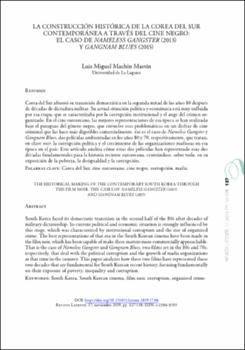La construcción histórica de la Corea del Sur contemporánea a través del cine negro: el caso de Nameless Gangster (2013) y Gangnam Blues (2015)
Author
Machín Martín, Luis MiguelDate
2019Abstract
Corea del Sur afrontó su transición democrática en la segunda mitad de los años 80 después
de décadas de dictadura militar. Su actual situación política y económica está muy influida
por esa etapa, que se caracterizaba por la corrupción institucional y el auge del crimen organizado.
En el cine surcoreano, las mejores representaciones de esa época se han realizado
bajo el paraguas del género negro, que envuelve esas problemáticas en un disfraz de cine
criminal que las hace más digeribles comercialmente. ése es el caso de Nameless Gangster y
Gangnam Blues, dos películas ambientadas en los años 80 y 70, respectivamente, que tratan,
en clave noir, la corrupción política y el crecimiento de las organizaciones mafiosas en esa
época en el país. Este artículo analiza cómo estas dos películas han representado esas dos
décadas fundamentales para la historia reciente surcoreana, centrándose, sobre todo, en su
exposición de la pobreza, la desigualdad y la corrupción. South Korea faced its democratic transition in the second half of the 80s after decades of
military dictatorship. Its current political and economic situation is strongly influenced by
this stage, which was characterized by institutional corruption and the rise of organized
crime. The best representations of that era in the South Korean cinema have been made in
the film noir, which has been capable of make these matters more commercially approachable.
That is the case of Nameless Gangster and Gangnam Blues, two films set in the 80s and 70s,
respectively, that deal with the political corruption and the growth of mafia organizations
at that time in the country. This paper analyzes how these two films have represented those
two decades that are fundamental for South Korean recent history, focusing fundamentally
on their exposure of poverty, inequality and corruption.





